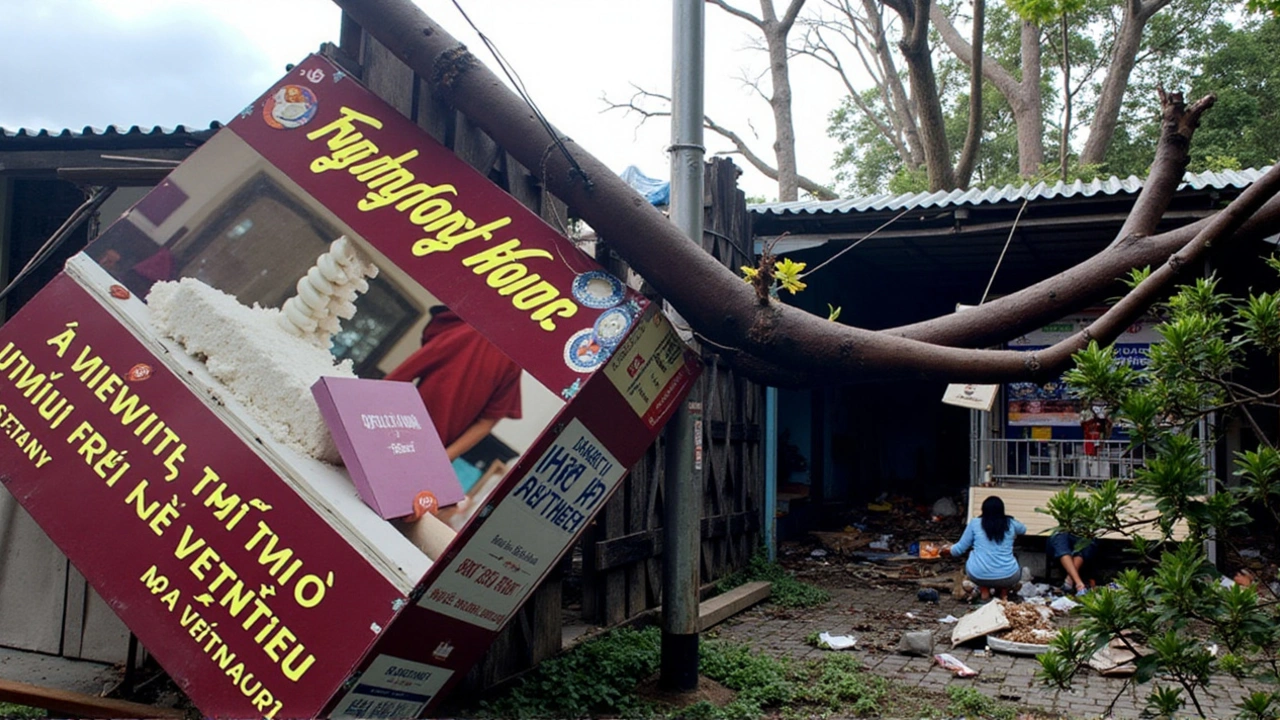Typhoon Yagi Hits Northern Vietnam with Devastating Force
In a dramatic display of nature's power, Typhoon Yagi tore through northern Vietnam over the weekend, leaving a trail of destruction in its wake. At least 14 people have been confirmed dead, and 176 others have sustained injuries in what Vietnamese officials have described as one of the most powerful typhoons to hit the region in a decade. The storm made landfall in the coastal provinces of Quang Ninh and Haiphong on Saturday afternoon, bringing with it wind speeds of up to 149 kilometers per hour (92 miles per hour).
A Wake of Destruction
For 15 hours, the typhoon raged across the landscape, uprooting trees, tearing away rooftops, and toppling electricity poles. By early Sunday morning, Yagi had weakened into a tropical depression, but the damage had already been done. Over 3 million people found themselves without electricity in northern Vietnam, and nearly 116,192 hectares of vital agricultural land, primarily used for growing rice and fruits, was severely affected. The agricultural sector, a backbone for many local communities, now faces a daunting recovery process. Furthermore, the storm's impact has brought daily life to a standstill, with hundreds of flights canceled and four major airports temporarily shut down.
Capital Under Siege
The capital city of Hanoi has been particularly hard hit. Municipal workers, army personnel, and police forces are racing against time to clear the manic mess left behind. Uprooted trees, fallen billboards, and debris are strewn across city streets. The arduous task of restoring normalcy involves assessing and repairing the structural damage to buildings, and ensuring the safe re-establishment of electrical power. However, the efforts to rebuild are hampered by ongoing weather concerns.
Forecasts of Further Challenges
As the clean-up effort progresses, Vietnamese meteorological officials have issued stern warnings regarding the severe weather conditions that might follow. Heavy rainfall is anticipated in northern and central provinces, exacerbating the risk of floods in low-lying areas, flash floods in streams, and landslides on steep slopes. Such secondary disasters could further hamper the recovery efforts and pose additional risks to the affected populations. Benjamin Horton, director of the Earth Observatory of Singapore, emphasized that climate change is making storms like Typhoon Yagi increasingly powerful. Warmer ocean waters are energizing these storms, leading to higher wind speeds and heavier rainfall. Horton's insights underline the broader, longer-term challenges that regions like Southeast Asia face due to changing climate patterns.
A Storm's Deadly Path Across Asia
Typhoon Yagi's destruction wasn't confined to Vietnam. Earlier in the week, the storm barreled through the northwestern Philippines, leaving 20 fatalities and causing 26 more individuals to go missing, many due to landslides and flooding. The typhoon then moved over the South China Sea before striking China, where it claimed three more lives and injured nearly a hundred people. The multi-nation path of Yagi demonstrates the widespread impact of these massive weather events, affecting millions and disrupting the infrastructure and lives of people across vast areas.
International Solidarity and Response
In the wake of Yagi, international aid organizations and neighboring countries have expressed solidarity with those affected. The need for emergency supplies, medical aid, and rebuilding assistance is critical. Relief efforts are being coordinated to ensure that essential resources reach the hardest-hit communities promptly. The international community's response underscores the importance of global collaboration in addressing and recovering from such wide-scale natural disasters.
Lessons and Future Preparedness
The catastrophic impact of Typhoon Yagi serves as a sobering reminder of the need for improved disaster preparedness and response strategies. Investments in early warning systems, resilient infrastructure, and public education on emergency procedures can mitigate the damage and loss of lives in future events. Additionally, addressing the underlying issue of climate change is paramount. Global initiatives to reduce greenhouse gas emissions and transition to sustainable energy sources are crucial in combating the intensifying effects of climate-related disasters.
As Vietnam and other affected regions begin the arduous journey to rebuild and recover, the poignant stories of loss, resilience, and communal support shine through. The efforts to restore and heal will be ongoing, but the lessons learned will hopefully lead to a more prepared and resilient future for all.




Wow, Yagi really ripped through Vietnam like a wild tiger! The images are heartbreaking, and I can’t help but feel for every family whose home turned into rubble. Let’s hope the region gets the help it deserves soon.
All this is just a staged distraction to push climate agendas.
It’s truly tragic, the scale of devastation is unimaginable, yet we must remember that communities across Southeast Asia have faced similar challenges before, and their resilience, shaped by generations of experience, offers a glimmer of hope, even as we watch the news unfold, we should support relief efforts, share verified information, and avoid sensationalism that only adds to the panic.
Hey everyone, let’s channel that energy into action! Donate, volunteer, and spread the word – together we can rebuild stronger than before.
When the wind howls and the rain drowns the earth, we are reminded of the fragile thread that connects humanity to nature. The story of Typhoon Yagi is not merely a news headline; it is a mirror reflecting our collective vulnerability. Each toppled tree, each shattered roof, whispers a lesson about the limits of our control. In the quiet moments after the storm, survivors gather the remnants of their lives, piecing together memories like mosaics. Their perseverance teaches us that hope can be forged in the crucible of loss. The floodwaters that cover rice paddies also wash away the complacency that often shields us from facing climate realities. As we watch the skies darken over distant lands, we must ask why we allow such forces to grow unchecked. The scientific community has warned us for years, yet political inertia persists. This tragedy becomes a call to action for policymakers, urging them to prioritize sustainable infrastructure. It also beckons each of us to examine our carbon footprints, for every emission contributes to a warmer ocean that powers stronger storms. The human spirit, however, remains unbreakable; volunteers rush to aid, and strangers become allies in the face of disaster. In those moments, borders blur and compassion knows no nationality. Let us honor those who have perished by committing to a future where preparedness outweighs panic. The rebuilding process will be long, but it offers an opportunity to embed resilience into the very fabric of communities. May the lessons of Yagi guide us toward a world where harmony with the environment is not a dream but a practiced reality.
Honestly, the media’s dramatics definatly overstate the impact – sure, there’s damage, but a lot of the hype is just cheap clickbait. I think there’s a hidden agenda pushing climate fear‑mongering, which is why I’m skeptical of the official numbers.
Friends, let’s turn this tragedy into a catalyst for positive change! 🌍💪 Donate, share verified resources, and keep the spirit of solidarity alive. Together we rise! 😊👍
yo the article is just a bunch of fluff u cant trust any of it its all lied down by the govt to push agenda most of the stats are fake btw the whole thing is over blown and ppl are just crying for attention
While it is essential to acknowledge the immediate humanitarian needs, it is equally important to underscore the strategic importance of robust, nation‑wide disaster preparedness frameworks. The recent typhoon underscores gaps that must be addressed through coordinated policy measures.